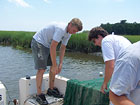

 | |||||||||||||||
|
|
Journals 2005/2006Sarah Mitchell
July 8, 2005 Today I was offered a chance to work with the DNR crew who work the lower sections of the creeks by boat. We left from the dock near the lab in two boats, bringing with us the NOAA crew that would be dropped off to work the lower section of the 1st order. The lab is located on St. John's Island, and to get to the mouth of Parrot Creek, we had to motor past Fort Sumter. It was nice to travel by boat and see a bit of the bay area. It was also nice to see how the work done here compared to what I had been doing.
After dropping off the lab crew that was hiking in to their site, the DNR staff began their work. Much of the process is the same. As this was the second day at this site, we needed to collect living samples. Rather than use a seine net though, because of the depth of the water, we trawled instead. Before tossing the net, the cod end, or open end, is tied off. This is where the catch will end up, and how they will be released from the net. While the boat is moving, the net is let out of the stern of the boat. To help the front end stay open there are two wooden "doors" that act like wings. Traveling at a set speed, the boat travels for 250 meters and then the net is brought in. In some respects this seemed much easier than trying to walk through the mud with the seine net, but it proved to have it's own difficulties as the twists and turns of the creek sometimes snagged the net. When the net is hauled in the catch is put into collecting buckets on board. An effort is made to return the catch back alive, but first they must be identified, counted and measured. Since we were in deeper water, it was no surprise that the catch yielded larger critters. While it was easier to identify things, pulling shrimp, squid and fish out of a bucket containing blue crabs provided a bit of a challenge. As this was the 2nd day at this site, we also had to collect the sondes which had been deployed yesterday.
|
||||||||||||||


